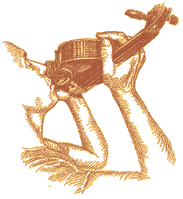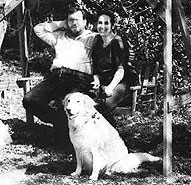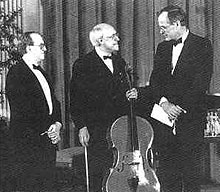
|
Ethan Winer talks to Robert and Deena Spear, American luthiers who combine pioneering scientific research on acoustics with the practical art of Stradivari. (This article first appeared in the July 1994 issue of The Strad magazine.)
Robert Spear's journey into a career of lutherie began with a short flight he took near the end of his third year in college. A car struck the motorbike on which he rode to classes and lofted him into a ditch. Luckily, roadside construction work provided a strip of freshly turned earth to cushion his fall. Unluckily, he landed on the only large stone in it, breaking both thumbs, and ending his hopes of a career as a professional bass player. "You might say I was moved towards lutherie by a power greater than my own," he reflects.
In 1972, Bob returned to Ithaca to conduct the high school orchestra and head the department of instrumental music. Although he continued to do repairs in a spare room of his apartment, he soon realised that he needed to study better instruments, and that these would not be brought to an untrained individual. He wrote to violin makers in various cities offering to indenture himself, and waited for replies. At length one shop answered, explaining that they did not take Americans "off the street," but relied on graduates of the European violin making schools. "Until then, I didn't even know there was such a thing as a violin making school," Bob recalls. "I was already in my late 20s and too old to apply." The years 1973 and 1974 were pivotal for him. He rented a window-less room in an old school building in Ithaca as a workshop, using the money he earned from repairs. He made the acquaintance of Carleen Hutchins, the pioneer researcher in violin acoustics, and was accepted into the first summer classes in violin making taught by Karl Roy (director of the Mittenwald School) at the University of New Hampshire in Durham. Also at this time Bob met Deena Zalkind, a biology graduate from Cornell University. Deena was looking for a way to learn violin making--an abrupt change from her original intention of going to medical school. Four years later, the couple were married.
The couple also attended classes over the years with Dr. Hutchins. "Her findings forever changed the way we thought about violin acoustics," Deena explains. The different philosophies of their two mentors constantly challenged the Spears to view violin making in terms of synthesis--to walk the fine line between traditional and modern schools of thought. Deena worked at the violin shop during the day while Bob continued instrumental teaching. In the evenings they would work together in the shop until late at night. The work doubled annually, and by the sixth year Bob had given up bass playing and resigned from his school work. They began to sneak into the shop on Sundays to do some fiddle making, but clients soon discovered their secret and came knocking on the door. "The fun was beginning to go out of it," Bob recalls. "We were no longer running the shop; it was running us. We were making about one fiddle per year, so something had to give." They decided to close their business and, following a brief stint at Peter Prier's violin making school in Salt Lake City, relocated to the Washington D.C. area in 1980. The couple moved their workshop to their home in Accokeek, MD, in 1986, where they have remained since. The Spears divide their labour along different lines to most instrument making couples. Bob does the preliminary joining of plates, cutting out rib stock and squaring scroll blanks. Thereafter, each makes the entire instrument individually; Bob focuses on violas and cellos, while Deena concentrates on violins. Bob does the final fitting up, while Deena finishes with acoustic work on the bridge, soundpost, and fingerboard. The Spears have now ceased all retail sales and repairs to concentrate on violin making and acoustic research. "We are engaged in a risky type of time-travel," Bob sighs. "One hour, we'll be in front of a computer, running maximum-length sequences on the air cavity of a violin or taking accelerometer readings from the rear of a cello scroll, and the next we'll be at the bench, graduating plates much as it was done three centuries ago."
While the viola turned out well, one success does not constitute a break-through. Testing and retesting a fiddle in whole and in parts, listening carefully as each change is made, and noting the results, takes time. "We don't make many instruments per year as a result," says Deena. "But we hope our research will pay off in the long run." One of the results of Deena's research has been new insights into the relationship of the fingerboard to acoustic performance. "We'd replaced hundreds of fingerboards over the years," she says. "Afterwards, the sound often changed--sometimes it was better, and sometimes worse, even though we'd followed traditional fingerboard dimensions exactly." Based on clues from an article by Carleen Hutchins, Deena's approach was to alter the length and thickness of the fingerboard to match it to certain vibrational modes in the body of the instrument. Deena's paper, "Achieving an Air/Body Coupling in Violins, Violas and Cellos; A Practical Guide for the Violin Maker" (Journal of the Catgut Acoustical Society, May 1987, p.4), describes her findings. Deena's discoveries in acoustic work are made using the ear as her guide; afterwards she uses electronics to see what differences can be measured. "Often we can hear what we have not yet learned how to measure," she comments. "As we become more sophisticated in our ability to measure, we gain more understanding of why a particular change works." Deena credits National Symphony Orchestra concertmaster William Steck and his wife Ann with training her ears to recognise the tonal subtleties that are so important to professional musicians.
Despite the fears of traditionalists that stringed instrument making may be reduced to computer algorithms, the Spears note that much room remains for the luthier's art. "The particular mode matching I achieved in Slava's cello has not so far occurred again," Bob explains, "because the next sets of wood I used simply did not allow it. This compelled me to find another way to achieve my goals. I have since made cellos that some say are equal to or better than Slava's, but by different means." What do the Spears do that is different than other makers? Just as in the old days, makers generally obtain their wood and varnish materials from the same trade sources, so everyone starts off more or less equal. The rest is careful observation, gentle persuasion, and a generous helping of experience. If a musician expresses a preference for a dark sounding instrument, it is possible to persuade the wood in that direction during plate tuning by observing the frequency of the dominant modes, either by machine or with traditional tapping methods. If the wood wants to be bright, however, it will always retain that basic character, no matter what is done to it. Forcing the pieces to a pre-conceived ideal generally produces poor results. Attention to detail is also important, like observing that wood that makes excellent bass-bars may not be the best for soundposts. The Spears check the free plates using techniques developed by Hutchins. The plates are suspended on blocks of soft sponge over a small loudspeaker. Black party glitter sprinkled on the plates moves to the nodal lines of major frequencies when swept with a sine wave generator. In the finished instrument, the Spears test for air resonances by suspending a small microphone and speaker inside the body cavity, and they test for wood resonances using an accelerometer. The computer uses either a swept sine wave or an impulse test using Liberty Instruments' low-cost Imp card and software Bob wrote with the help of electrical engineer Alex Thornhill. The Spears sometimes collaborate with physicist George Bissinger to run modal analysis tests on an instrument and study the effects of experimental changes.
Interview with Mstislav Rostropovich Ethan Winer: I'd like you to share your thoughts on modern instruments, and in particular the cello you bought from the Spears. Mstislav Rostropovich: I like the Spears' instrument enormously. I have played many concerts and recitals on it, including my recital at the White House for President Bush. The relationship between an instrument and performer is very special--like that between friends or a couple in love.
MR: Now that I'm a little older, I have developed a philosophy. I think it's necessary for a performer, if you are skillful, to use different instruments--not only for the difference in colour, but also for a different "shape." If you always play one instrument you become stiff. I like my Stradivari very much. But for playing modern music I prefer modern instruments. EW: How many cellos do you have? MR: I have many. Some are gifts from friends, which I very much appreciate. For example, for my 50th birthday I received a cello from Etienne Vatelot. It's a fantastic cello, and I play it in many concerts with orchestra. Practically, I play four instruments: the Stradivari, a Lorenzo Storioni, my friends Bob and Deena's, and the Vatelot. EW: How do their sounds differ? MR: The Stradivari has a magical sound--like a human voice, a spinto tenor. My Stradivari is the "Duport" of 1711, the most famous violoncello in the world. It has a great history. Napoleon played this cello, and Duport played it in Wiesbaden with Beethoven in the first performances of the "Archduke" Trio. There is much silver in the timbre of a Stradivari, but it is not enormously strong. For modern concertos I need to get a "nasty" sound that is impossible to produce with my Stradivari. So, for example, I like the Storioni very much for a big hall. It combines a bit from the modern and a bit from the Stradivari. The main point is that for different repertoire I prefer a different instrument. |
 deena@singingwoods.org We always respond to those who contact us by e-mail. If you do not get a reply, we did not get your communication, so please try reaching us again. Thank you. |





